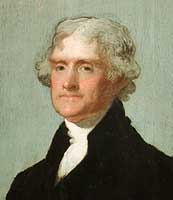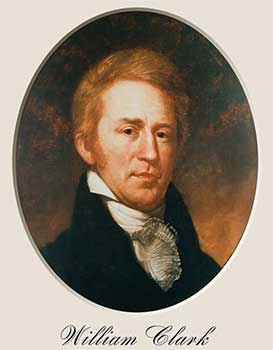William Clark is most famous for his co-leadership of the epic Lewis and Clark Expedition of 1804-06. Less well-known are his contributions to American Indian diplomacy, which occupied a large portion of the remainder of his career. If not for the positive relations maintained by Clark with several tribes during the crucial early years of westward expansion, the map of the United States might look significantly different today. Blending fairness, honesty and strength with patience, respect and understanding, Clark recognized the personal dignity of American Indians, honoring their cultures and religious beliefs.
William Clark was born in 1770 to John and Ann Rogers Clark in Caroline County, Virginia, the ninth of ten children. He grew up on his father's plantation with its many acres and slaves, enjoying life in the open country. Though he had little formal education, he acquired the manners and accomplishments of a Virginia gentleman of his day, including riding, hunting, surveying, and managing an estate. In the autumn of 1784, the Clark family moved to Kentucky, and on a large tract of land near Louisville built a home called Mulberry Hill. On the Kentucky frontier, Clark matured rapidly. The six foot tall, red-haired youth seemed more of a frontiersman than a Virginia planter, with a bluff, direct manner of speech and a love for the hills and woods of his new home.
At the age of 19, Clark joined the militia, and soon gained a captaincy. In 1791, he transferred to the regular army as an ensign, advancing to the rank of lieutenant under Anthony Wayne. For four years he lived in the field with the western army in Ohio and Indiana, learning the practical principles of military command, engineering, construction and topography. He also gained a greater knowledge of wilderness survival and a curiosity and respect for the American Indians he encountered.
Resigning his commission in 1796, William Clark returned to Mulberry Hill, where he tried to untangle the complicated financial affairs of his famous older brother, George Rogers Clark. Clark's father died in 1799, and his mother the following year. Although not the oldest son, William inherited Mulberry Hill, as well as most of the family's slaves and debts. One day in 1803, a letter arrived from Meriwether Lewis, a young officer who had served with Clark in the western army, offering him a chance to serve as co-leader of the government-sponsored Corps of Discovery, scheduled to explore the American continent over the Rocky Mountains to the Pacific Ocean. Clark sold Mulberry Hill to his oldest brother, Jonathan, and set out on the epic journey which would bring him lasting fame.
During the trip, William Clark became adept at diplomacy with American Indians, as well as an accurate observer and recorder of their culture, religion and customs. On September 23, 1806, the Lewis and Clark expedition returned to St. Louis after nearly 2 1/2 years in the wilderness. It took over a month to close the affairs of the expedition, and then, with pack horses carrying zoological and botanical specimens, Lewis and Clark, accompanied by Chief Sheheke of the Mandans and others, set out for Washington, D.C. At Louisville, Kentucky, Clark and his slave York stayed behind to visit relatives, while the rest of the party continued on to the capitol. Clark arrived in Washington after the formal celebration, and stayed seven weeks.
 |
| Thomas Jefferson. |
One of Clark's longest-running battles was over the "factory system" of Indian trade. This system, in effect from 1795 to 1822, was administered through a chain of 28 government-owned and operated stores, (of which only seven or eight operated at any given time), run by men called "factors." The factory system was meant to offset the influence of the English and Spanish over various Indian tribes, to strengthen U.S. military policy, to promote peace on the frontier, and to protect the Indians from exploitation by private traders. Clark believed that the goodwill he established through his personal contacts with Indian leaders would be jeopardized if the factory system were abolished.
In January, 1808, Clark married 16 year old Julia Hancock, with whom he had five children. St. Louis became his home, where he often held several offices at the same time and was involved in the fur trade and real estate. In 1813 he was appointed first governor of the newly created Missouri Territory, and was reappointed three times, until Missouri achieved statehood in 1821. Clark ran for the post of governor of the new state in 1820, but lost. He was not able to campaign because Julia had fallen ill during a trip to Kentucky, where she died tragically at the age of 28. Another reason for Clark's political loss was his support of the factory system of trade with the Indians. Opposed by a group of fur companies and traders led by Senator Thomas Hart Benton, the factory system was abolished in 1822.
William Clark recovered from his grief and defeat, marrying Harriet Kennerly Radford, a widow who was also a cousin of his first wife, and putting his energies into the administration of Indian affairs in the west. As Superintendent of Indian Affairs at St. Louis, Clark set up a system of Indian agents, many of whom were former army officers, who lived at the agencies they administered with individual tribes. Clark's skills at Indian diplomacy were successful in maintaining a long peace with many tribes. He participated in treaty negotiations for the government, negotiated intertribal disputes, drove squatters off Indian lands, and prevented Indians from returning to lands they had ceded by treaty. Clark persuaded the Sioux and other tribes, potentially hostile to U.S. interests, to side against Britain or remain neutral during the War of 1812. His influence probably saved the upper Mississippi Valley territories for the United States. Clark negotiated treaties with Indian tribes which had formerly been allied with Great Britain at the conclusion of the war. These treaties, which required acknowledgement of U.S. sovereignty, were formalized between 1815 and 1817 at Portage des Sioux, Wisconsin and in St. Louis.
The Sioux and Chippewa, bitter enemies for over a century, often drew neighboring tribes into their feud. In the interests of the U.S. Government, and to improve trade on the frontier, a treaty was negotiated in 1825 at Prairie du Chien to create an official boundary between the tribes and resolve trading rights. More than one thousand chiefs assembled in conference with Commissioner Clark and Governor Lewis Cass of the Michigan Territory. Unlike other Indian treaties which demanded cessions of land, this treaty established boundaries between tribes, which they agreed to respect.
William Clark was accepted by the Indians as their friend and advocate, a man who tried to obtain as much justice for them as possible. His name on greetings and messages to Indians provided the protection of the government to men on fur trading expeditions. Known as the "red-haired chief", he was called upon by countless tribal delegations at his home in St. Louis. The presents given to him of clothing, weapons, handicrafts and ceremonial items were displayed in an Indian museum in a building next to Clark's house on First Street (now the north triangle on the Arch grounds). Unfortunately, this priceless collection was loaned for exhibition in Germany prior to Clark's death and was lost or destroyed in the 1830s.
On September 1, 1838, after a brief illness, William Clark died at the age of 69 in the home of his son on Broadway in St. Louis. After a grand funeral procession which stretched over a mile along the streets of St. Louis, Clark was buried with masonic and military honors outside the city, on the farm of his nephew, Col. John O'Fallon. The gravesite is today incorporated within the boundaries of Bellefontaine Cemetery. A son by his second wife, John Kennerly Clark, bequeathed money for a monument over the grave, erected in 1904.
The general goodwill with the Indians fostered by Clark as Indian agent created a favorable climate for westward expansion. His efforts at peace and understanding between Indians and whites and the settlement of intertribal disputes set a tone for the conduct of Indian affairs which was unfortunately not continued by others following his death. William Clark's place in history as an explorer is secure, but his efforts as a diplomat and peacemaker in the American west should also be recognized as an essential contribution to our American heritage.
